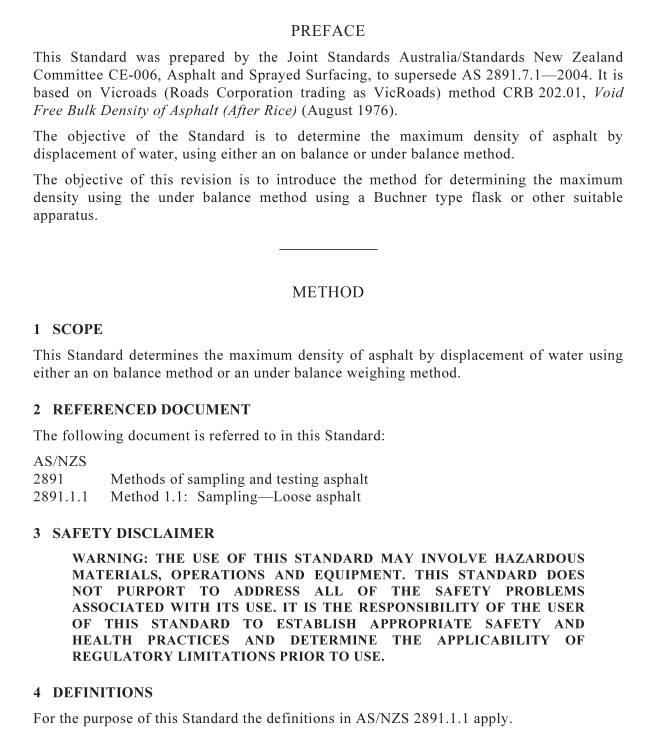AS NZS 2891.7.1 pdf download – Methods of sampling and testing asphalt Method 7.1: Determination of maximum density of asphalt—Water displacement method

AS NZS 2891.7.1 pdf download – Methods of sampling and testing asphalt Method 7.1: Determination of maximum density of asphalt—Water displacement method
5 MATERIALS
The following materials are required:
(a) Potable water.
(b) Optional detergent solution with 5 mL of commercial grade concentrate diluted with 1000 mL of water. NOTE: Use of detergent in the water whilst vacuuming will increase the efficiency of the removal of air from the sample.
6 APPARATUS The following apparatus is required:
(a) Pycnometer for on balance method A flat bottomed thick-walled flask, able to withstand a vacuum of −90 kPa gauge pressure or lower, of about 2 L capacity; the top of the mouth of the pycnometer shall be ground flat. The flask shall either have a side arm for attachment of the vacuum line or be fitted with a rubber stopper with provision for a vacuum tube.
(b) Pycnometer lid A glass plate slightly larger than the top of the pycnometer and ground flat on one or both sides.
(c) Flask for under balance method A flat bottomed thick-walled flask or vacuum pot of plastic or alloy, with transparent cover of sufficient capacity to allow vacuum evacuation of the specimen fully immersed in water with rubber seal and a connection for vacuum. The flask shall be capable of withstanding a vacuum of −90 kPa gauge pressure or lower. NOTE: Suitable forms of vacuum flasks and pycnometers of alloy and heavy gauge plastic are available commercially for determination of maximum density of asphalt using the methods given in this Standard.
(d) Water/vapour trap Fitted in line before the vacuum pump to prevent the transfer of water and water vapour to the vacuum pump.
(e) Vacuum system Comprising a vacuum pump capable of maintaining a vacuum of −90 kPa gauge pressure or lower in the pycnometer or flask, tubing and an inline device for measuring the vacuum such as a vacuum gauge.
NOTE: The inline device for measurement of the vacuum should be fitted using a ‘T’ piece type connector and should be located towards the end of the vacuum line near the pycnometer or flask.
(f) Water bath The bath shall have a means of maintaining a constant temperature of 25 ±1°C or within 1°C of an alternative test temperature. The bath should be emptied and cleaned at regular intervals to ensure that the water in the bath is clean and not contaminated. For the on balance method, the bath shall be filled with clean water and have sufficient capacity to contain the immersed body of the pyconometer. For the under balance method, the bath shall be fitted with an overflow and filled with clean water to the level of the overflow at all times. The dimensions of the bath shall be such that the fully immersed flask shall be at least 50 mm from the sides and bottom of the bath.
(g) Balance Of suitable capacity and with a limit of performance not exceeding ±0.5 g.
(h) Balance attachment To support the flask whilst fully submersed in the water bath. The attachment shall be constructed of non-absorbent corrosion resistant material and fitted to ensure errors to weighing due to buoyancy effects from water levels on the attachment do not affect the required accuracy of the results.
(i) Oven To heat asphalt so that it can be prepared satisfactorily.
(j) Thermometer A thermometer or other suitable temperature-measuring device covering a range of 0°C to 50°C, readable and accurate to 1°C or less.
7 PREPARATION OF TEST PORTION Unless otherwise specified, the test sample shall be obtained in accordance with AS/NZS 2891.1.1 and prepared as follows:
(a) Warm the test sample in the oven sufficiently to loosen the material and reduce the test sample in accordance with AS/NZS 2891.1.1 to obtain two test portions with a mass complying with Table 1.
(b) Separate the particles of the test portion into the smallest size practical without compromising the binder coating on particles. Aggregations of fine particles shall not be greater than 6 mm in size.









